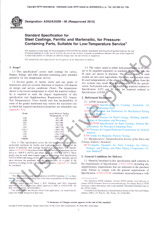We need your consent to use the individual data so that you can see information about your interests, among other things. Click "OK" to give your consent.
ASTM D8473-22
Standard Test Method for Determining the Biobased content of Liquid Hydrocarbon Fuels Using Liquid Scintillation Counting with Spiked Carbon-14
Translate name
STANDARD published on 15.9.2022
The information about the standard:
Designation standards: ASTM D8473-22
Publication date standards: 15.9.2022
SKU: NS-1087777
The number of pages: 15
Approximate weight : 45 g (0.10 lbs)
Country: American technical standard
Category: Technical standards ASTM
Annotation of standard text ASTM D8473-22 :
Keywords:
biobased, bomb carbon, 14C (carbon-14), carbon dating, liquid scintillation counting, new carbon, old carbon, percent modern carbon,
Additional information
| Significance and Use |
|
5.1?This test method provides accurate biobased/biogenic carbon content results to materials whose carbon source was directly in equilibrium with CO2 in the atmosphere at the time of cessation of respiration or metabolism, such as the harvesting of a crop or grass living in a field. Special considerations are needed to apply the testing method to materials originating from within artificial environments with non-natural levels of 14C or if the biofeed was grown over the course of several years such as trees and contains bomb-carbon. Application of these test methods to materials derived from CO2 uptake within artificial environments is beyond the present scope of this standard. 5.2?This method uses LSC techniques to quantify the biobased content of a liquid hydrocarbon fuels using sample carbon that has been unmodified. It is designed to be able to incorporate into a refinery laboratory to support biofeed and petroleum coprocessing or blending operations to determine the biocarbon content of the intermediate or finished products. The test results can then be used for optimizing internal parameters or reporting to regulatory agencies. 5.3?The use of this method requires that a pure petroleum-based sample can be generated that has a similar matrix to each product or stream to be analyzed. For example, gasoline and diesel have very different matrices and will likely require the use of different background measurements for each. Refer to 10.2 for how to determine if the same background sample can be used for more than one product/stream. |
| 1. Scope |
|
1.1?This test method covers quantitatively determining biocarbon content of liquid hydrocarbon fuels with a focus on those produced in a typical petroleum refinery using liquid scintillation counting (LSC). The method is designed to generate analogous results as Test Method D6866 Method C, for low quench samples, without the need of benzene synthesis. The purpose is to be able to use the produced data to report biocarbon content of refinery products to regulatory agencies and monitor refinery operation. The method does not address regulatory reporting or fuel performance. 1.2?The method is needed to support refinery operations when bio-feeds are co-processed with petroleum within a reactor with a focus on samples with 100 % biocarbon or less (not for 14C labeled species). It allows refineries to report the biocarbon content of refinery products to regulatory agencies such as the Environmental Protection Agency (EPA) or California Air Resources Board (CARB) to comply with regulatory statutes such as The Renewable Fuel Standard (RFS) or Low Carbon Fuel Standard (LCFS). 1.3?This test method is applicable to any liquid fuel product, petroleum based (pure hydrocarbon), biobased (such as renewable diesel or those that can contain oxygenates such as ethanol), or blends, that contain 1 % to 100 % by mass biocarbon where an instrument background can be experimentally determined using a sample of similar matrix that contains no measurable carbon-14. 1.4?This test method makes no attempt to teach the basic principles of the instrumentation used although minimum requirements for instrument selection are referenced in Refs 1.5?Pre-Requisite Requirements For Method ExecutionThis test method uses artificial carbon-14 (14C) within the method. Great care shall be taken to prevent laboratory contamination of the elevated 14C. Once in the laboratory, artificial 14C can contaminate a variety of laboratory surfaces that can lead to artificially high sample biocarbon measurements. If vigorous cleaning attempts to remove the artificial 14C from a laboratory are unsuccessful, instrumentation and sample preparation may have to be moved to a new laboratory away from the contamination or the laboratory may have to rely on outside third-party labs for analysis. Specific procedural steps have been incorporated into this method that minimize the risk of sample and lab contamination. Wipe tests and quality assurance samples can validate absence of contamination. In the event of contamination in the laboratory or instrument, vigorous cleaning protocols shall be implemented, and analysis cannot be resumed until the lab and instrument are free of contamination. Accepted requirements are: 1.5.1?Working with the elevated 14C samples in a separate and defined area away from the instrument and the preparation of any non-spiked samples. 1.5.2?Using separate personnel to prepare the spiked samples and non-spiked samples. 1.5.3?Using separate laboratory spaces with separate HVAC systems for the handling of spiked and non-spiked samples. The use of separate fume hoods that have separate exhaust ventilation satisfies this requirement. 1.5.4?Weekly wipe tests of 14C sample handling area(s) to detect lab contamination. 1.6?This standard does not purport to address all of the safety concerns, if any, associated with its use. It is the responsibility of the user of this standard to establish appropriate safety, health, and environmental practices and determine the applicability of regulatory limitations prior to use. 1.7?This international standard was developed in accordance with internationally recognized principles on standardization established in the Decision on Principles for the Development of International Standards, Guides and Recommendations issued by the World Trade Organization Technical Barriers to Trade (TBT) Committee. |
We recommend:
Updating of laws
Do you want to be sure about the validity of used regulations?
We offer you a solution so that you could use valid and updated legislative regulations.
Would you like to get more information? Look at this page.




 Cookies
Cookies
